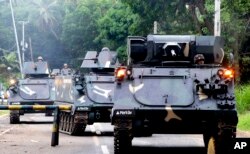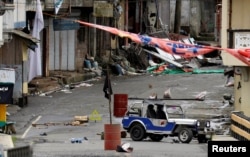Moments after the first reports of gunfire and flames at a resort in the Philippine capital of Manila, social media accounts of Islamic State terror group supporters went into action.
“There’s been an explosion of posts,” said Michael Smith, a terrorism analyst who has consulted with the U.S. and British governments, as the events were unfolding late Thursday.
Although not at all unusual, the activity reflected the high hopes among IS supporters. Some went as far as to claim the incident as an IS attack.
One self-professed IS operative from Marawi City, where the group has a toehold, was quoted by SITE Intelligence as saying it was carried out by “lone wolf soldiers of Khalifah [the caliphate].”
Not a terrorist
Hours later, though, to the disappointment of the same IS adherents, word slowly began to spread that the incident at the Resorts World Manila complex was likely not related to IS at all.
“We cannot attribute this to terrorism,” Philippine National Police chief Ronald dela Rosa said, noting the gunman stole casino chips and had not actually fired at people.
Early Friday, Metropolitan Manila police chief Oscar Albayalde told the Associated Press that the English-speaking suspect was found dead with his rifle on the fifth floor of the Resorts World Manila complex. He says the gunman apparently killed himself.
An IS nucleus?
Still, Thursday’s incident underscored long-standing concerns about Islamic State’s plans for Southeast Asia, where researchers have warned of the “creation of an IS nucleus.”
“The porous nature of the terrain — heavily forested — and the strategic location of the South Philippines make it lucrative,” Rohan Gunaratna of the Centre for Political Violence and Terrorism International Research warned in the May 2017 edition of Counter Terrorist Trends and Analyses.
Researchers like Gunaratna say IS has used the past two years to consolidate and expand, gaining the allegiance of dozens of existing groups in the Philippines, while also actively recruiting from surrounding areas.
At the same time, pro-IS groups may have gotten a boost from foreign terrorist fighters.
IS “has called on followers in Southeast Asia to go to the Philippines if they cannot travel to Syria,” according to a U.S. intelligence official who spoke to VOA on condition of anonymity.
Some Philippine officials even have blamed recent fighting between government forces and Islamist groups in the southern part of the country on the Islamic State’s call, describing it as an “invasion by foreign terrorists.”
A terrorist diaspora
Western intelligence officials have so far been hesitant to discuss just how many IS fighters have made the journey from Iraq, Syria and elsewhere to the Philippines, saying accurate estimates are hard to determine.
The majority of U.S. intelligence warnings have focused on the potential for a terrorist diaspora, made up of fleeing foreign fighters, coalescing and targeting the West, notably Europe and the U.S.
Still, the journey between Iraq or Syria and Southeast Asia is possible.
A study by The Soufan Group found that, as of late 2015, there were at least 600 Southeast Asians who had traveled to Syria, some to fight under the banner of IS. And European officials have warned of a “sort of global market for irregular migration,” with human traffickers actively looking for opportune times to smuggle people from the Middle East to Southeast Asia and even to Australia.
Australian intelligence officials also believe there is a significant danger, cautioning that Southeast Asia could evolve into a magnet for would-be jihadists and foreign fighters, following the collapse of the terror group’s self-declared caliphate in Iraq and Syria.
There also are thoughts that some potential barriers to using the Philippines or other nearby areas as a base for IS operations may be overblown.
“The disadvantage to Southeast Asia is it’s remote and ethnically a lot of ISIS fighters would stick out,” said Daveed Gartenstein-Ross, a senior fellow at the Washington-based Foundation for Defense of Democracies. “But all of that was true also of Afghanistan when al-Qaida made it its center of gravity.”
Fighters likely locally directed
Still, questions remain about the extent to which IS leaders in Iraq and Syria have command and control over IS groups in the Philippines and whether they ordered the recent offensive in the south.
“Based on past offenses like this … it’s likely locally directed,” said Gartenstein-Ross, although he refused to rule out the possibility IS leaders may have been involved.
“The other possibility is it’s just a show of force,” he said. “They want to show they’re still strong across multiple countries.”










